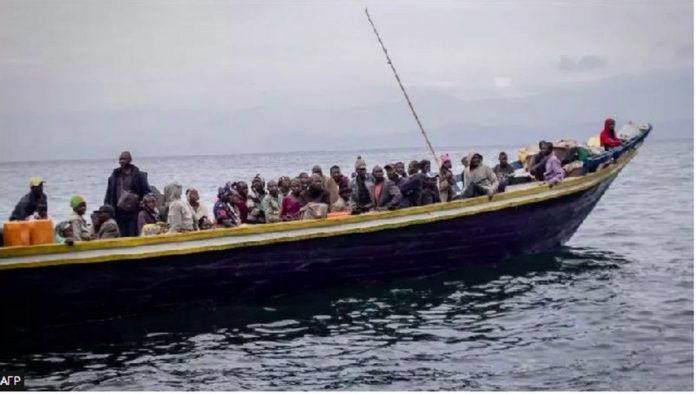Rescue workers are searching for 167 people still missing after their boat capsized in the Democratic Republic of Congo on Friday, officials have said.
More than 40 bodies have been recovered, while 189 survivors were rescued after the boat sank in the Congo River.
The boat was overloaded with more than 300 passengers and cargo, said a civil society group involved in rescue and recovery efforts.
Boats are a common mode of transport in DR Congo because of the lack of roads.
However, boat accidents are frequent due to overloading, a lack of maintenance and travelling at night.
Many passengers also do not wear life jackets.
Officials say that the boat was sailing at night in breach of safety regulations.
Prominent DR Congo opposition leader and presidential candidate in December’s election, Moise Katumbi, said he was saddened by “this tragedy”.
He said it was a “direct consequence” of the government “which tolerates the overnight navigation of dilapidated and overloaded boats”.
UN-linked Radio Okapi reports that the provincial government of Equateur, where the accident happened, said it would provide psychological support for children who were injured in the accident and lost their parents.
The radio station said that more than 40 bodies had been so far recovered but the local civil society organisation, Conscious Generation, said that the number was 50.
A survivor told Radio Okapi that the boat, which had left the city of Mbandaka for the Bolomba area in the north-western Equateur province, stalled and lost balance due to overcrowding.
While the crew attempted to rebalance the boat, it overturned with the passengers and cargo before sinking, the survivor added.
On Sunday, the vice-governor of Equateur province provided body bags and coffins for the burials of some of the victims.
I dare him
I will quit politics if Owusu Bempah is able to lead protesters to Mahama’s office
The Ghana Meteorological Agency (GMeT) has cautioned that the distribution of this year’s September to November rainfall may lead to more localised floods in low lying areas within Accra and Kumasi.
It said there was also a high chance of heavy flood in the northern part of the country due to the quantum of the rainfall expected in those areas and the likelihood of the spillage of the Bagre Dam in Burkina Faso.
This was contained in this year’s September October November (SON) forecast made available to the Daily Graphic.
Advertisement
The Deputy Director and Head of Research and Applied Meteorology at GMeT, Francisca Martey, said the current rainfall pattern, as captured in the forecast, was not out of the ordinary.
SON rainfall
The agency said this year’s SON rainfall was expected to be above normal for most places in the country, except for some areas in the south-western parts around Asankragwa in the Western Region, and the transition portions of the country — referring to Kintampo and surrounding areas of the rain forest regions towards the northern areas — where rainfall was expected to be normal.
Most of the rainfall, it said, would be in the form of light to moderate rain spread over several hours, with some few heavy incidences expected.
It said many places in the northern part of the country would also experience mostly above normal rainfall.
At the peak of the SON season, it said, there was a high probability of a few incidences of heavy rain accompanied by strong winds and lightning, which could lead to localised floods.
“Flash floods may occur, especially in the month of October, in places such as low lying areas of Accra and Kumasi during the September to November period. This may lead to some roads becoming impassable when it rains,” the agency said.
It revealed that at the beginning of the minor season, short to normal dry spells were expected, while towards the end of the season, longer to normal dry spells were expected over most places in the southern regions of Ghana.
It said this year’s rainfall season for the coastal towns and its surrounding inland areas was likely to end earlier as compared to their normal dates.
In addition, it said, most places in the forest areas would have their season ending on the normal dates.

